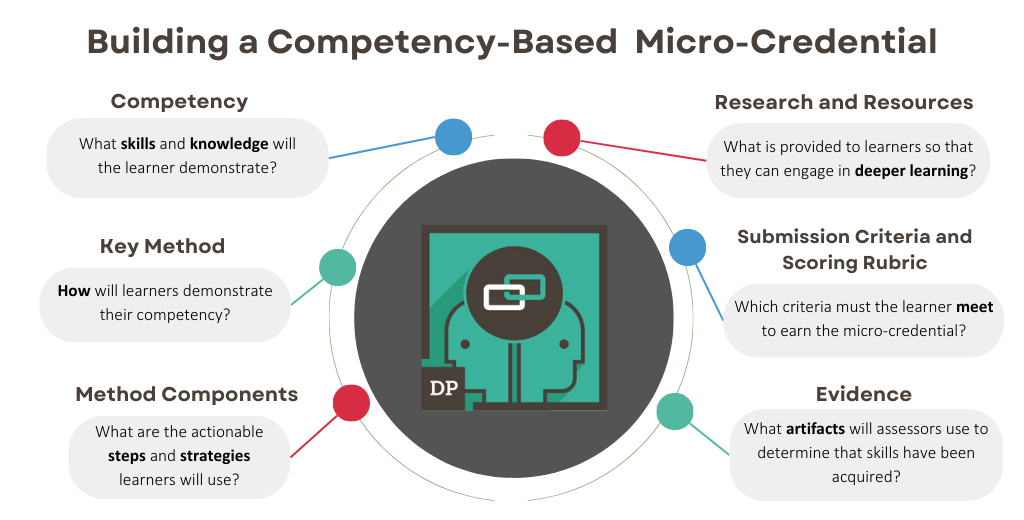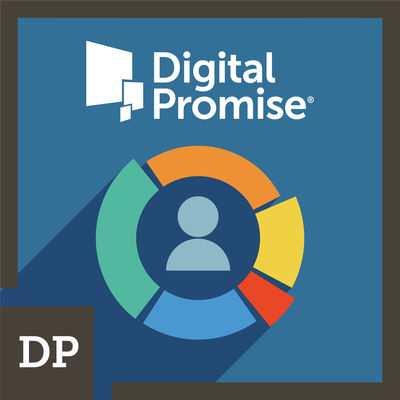Digital Promise’s approach to micro-credentialing is deeply rooted in research and transparency. Digital Promise’s micro-credential framework is a comprehensive template that guides partners through creating effective micro-credentials that align with research-based practices. Created in 2013, the framework is transparent: learners are trusted, and it is important for them to receive all the information about the micro-credential upfront, including their corresponding rubrics. By providing partners with a framework, Digital Promise enables the development of competency-based micro-credentials based on research, evidence, and transparency.
Research-based
When working with a partner, Digital Promise shares the micro-credential framework to serve as the template for partners to start developing their micro-credentials. The sections include competency, key methods, method components, supporting research and rationale, resources, and submission guidelines and evaluation criteria, with each providing prompts for what is to be included. There are also reminders throughout the template on the importance of basing the micro-credential in relevant, specific, and timely research.

Competency
- The competency section describes “WHAT” the learner is being asked to show or demonstrate. The “WHAT” is a description of the research-based skill (i.e., the learner collaborates with community stakeholders on a shared goal).
Key Method
- The key method section describes “HOW” the learner will accomplish the specific competency. This “HOW” is a research-based approach or method.
Method Components
- The method components section expands the research-based approach or method stated in the key method section by providing details. These details include how the learner will collaborate with community stakeholders through project-based learning.
- This section sometimes provides important background information and defines key terms.
Research
- The research section states what research—including evidence-based books, journal articles, and reports—says are the competencies and key methods learners should engage with to achieve the desired outcomes of the micro-credential.
- At least five references should be peer-reviewed research from the last 5-7 years and at least 80 percent of the references should be free to access for learners.
Resources
- The resources section provides any knowledge the learner can easily access to support the development and demonstration of competence in the skill or set of skills.
- Resources can include templates, online modules, blogs, videos, planning guides, and/or frameworks, and at least 80 percent of the references should be free to access for learners.
Submission Guidelines and Evaluation Criteria
- Providing options for the learners to demonstrate competency to meet their diverse learning needs is critical. The submission guidelines and evaluation criteria section comprises three parts: overview questions, work examples/artifacts, and reflection.
- The overview questions section provides context for and describes the work examples, evidence, or artifacts submitted in this section.
- The reflection section allows the learner to reflect on their experience by answering questions on what they have learned, how the skill has impacted their current practice, what they would improve on, and how the skill will impact their future practice.
- There must be alignment between the elements described in the key method/method components section and the submission guidelines and evaluation criteria section.
Transparency
Digital Promise firmly embraces transparency and advocates for it. When individuals seek to explore our micro-credentials, they are not required to create an account to access them. When viewing a micro-credential, its corresponding rubric can also be seen. It is identical to the one assessors use to evaluate the evidence submitted by the learner. This ensures there are no hidden metrics or surprises in the process.
Learners do not face hidden steps or unexpected challenges when pursuing a Digital Promise micro-credential. From beginning to end, the transparency of what skills a learner has to demonstrate and how they are evaluated provide visibility that encompasses all Digital Promise branded micro-credentials. These micro-credentials are trusted due to the quality assurance and research-based practices used to develop it.
All Digital Promise-developed micro-credentials—denoted with a “DP” on the badge—undergo the quality assurance and research-backed process.
 Digital Promise’s transparency and research-based micro-credential design reflects its commitment to expand opportunities for every learner, specifically historically and systematically excluded learners. By providing partners with the micro-credential framework and resources to develop quality micro-credentials, Digital Promise is driving meaningful change in how skills are recognized.
Digital Promise’s transparency and research-based micro-credential design reflects its commitment to expand opportunities for every learner, specifically historically and systematically excluded learners. By providing partners with the micro-credential framework and resources to develop quality micro-credentials, Digital Promise is driving meaningful change in how skills are recognized.
Digital Promise has been a pioneer in competency-based micro-credentials and has more than 10 years of experience in supporting organizations with their micro-credentialing needs. If you are interested in learning more about micro-credential services, please contact us at microcredentials@digitalpromise.org.


 Digital Promise’s transparency and research-based micro-credential design reflects its commitment to expand opportunities for every learner, specifically historically and systematically excluded learners. By providing partners with the micro-credential framework and resources to develop quality micro-credentials, Digital Promise is driving meaningful change in how skills are recognized.
Digital Promise’s transparency and research-based micro-credential design reflects its commitment to expand opportunities for every learner, specifically historically and systematically excluded learners. By providing partners with the micro-credential framework and resources to develop quality micro-credentials, Digital Promise is driving meaningful change in how skills are recognized.